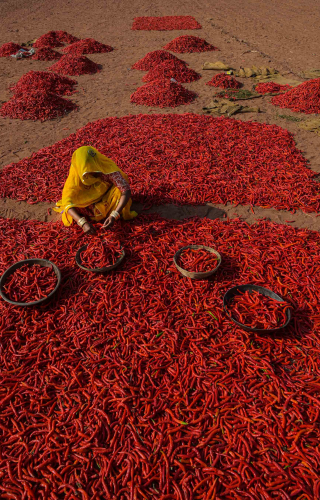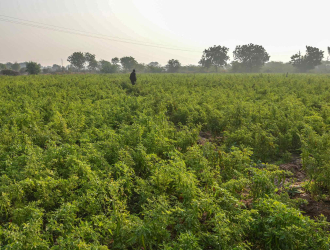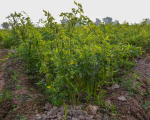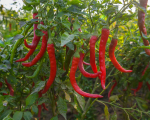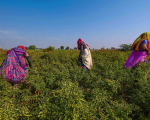India is the largest chilli-producing country in the world. Though much sought after in Europe for its home-grown spices, the chilli was not native to India. It originated in Mexico and was introduced to Europeans during the Columbian Exchange which followed the discovery of the Americas. Chilli is believed to have arrived in India from South America, colonised by the Portuguese who had established themselves in the spice trade in India. Red chilli soon became widely available in Indian kitchens due to its similarity with black pepper (Piper nigrum),which was already an essential ingredient in Indian cuisine and Ayurveda. This relatively recent arrival of chilli in India is evidence how the culinary heritage of the subcontinent has evolved over centuries and has been enriched by factors like trade, colonisation, migration and globalisation. Impact of climate, food habits, agricultural methods, soil texture and cooking techniques has resulted in further diversification and inspired local elements of flavour and texture, shaped by availability and usage of spices and herbs.
The dry, hot climate of Rajasthan makes it ideal for chilli cultivation. Located 35 km from Jodhpur, Mathania produces one of the finest varieties of red chillies (lal mirch) in India, known for its sharp pungent heat; it brings distinct flavour, colour and taste to food and is used in preparation of famous Rajasthani dishes like Laal Maas (red meat) and Ker Sangri. While cooking, lal mirch is used either whole, in paste form or in powder form. Additionally, chilli can be pickled by soaking them in mustard oil. Roasted red chillies are served separately as a taste enhancer. Also consumed in Rajasthan is an intense lal mirch chutney made from red chilies soaked overnight and ground with garlic and other spices.
Families farming chillies in Mathania have been doing so for the last 7–8 generations, which takes us to the late eighteenth or early nineteenth centuries, when chillies were likely introduced in Jodhpur state. Over the last two centuries, traders from Marwar (known as Marwaris) have been supplying Mathania’s unique lal mirch to different parts of the country. A fourth-generation chilli trader from Mathania, 21-year-old Khiwraj Parihar has prodigious knowledge about chillies. He explained to me that chilli is basically a fruit (genus Capsicum). The chilli pod contains seeds, and it originates from the flowering part of the plant. The substances that give chilli peppers their pungency (spicy heat) when ingested or applied topically, are capsaicin and several related chemicals, collectively called capsaicinoids. Capsaicin is a chemical irritant produced by the plant as a defense mechanism against mammalian predators and microbes, in particular a fungus that attacks certain species of chilli peppers. The hotness of capsaicin is utilised in medicine as an analgesic to relieve pain.
The chilli cultivation season in Rajasthan is during winter. The first fruits (red chillies) start to develop in December and continue growing till late February. The temperature and soil condition give chillies their distinct pungent taste and flavour. Farmers state that colder winters produce better quality chillies, and their production is sensitive to climate change. Although pesticide and fertilizer usage have increased, yield have reduced over time. While organic chillies fetch a premium price, many farmers have adopted organic farming but they too are facing a similar fate. Mathania's chili production has also decreased because of dropping groundwater levels. In a state like Rajasthan which has limited rainfall, farmers have developed an extensive zero-waste irrigation system. Even then, yield per hectare is less than what used to be 2–3 decades back, when irrigation was comparatively difficult.
Traders in Mathania buy chillies directly from the farmers, using the old measuring system of maund (equivalent to 40 kg). They are then sorted to remove the bad ones. After the morning mist is cleared, women spread the chillies in large batches to dry in the sun. The processes of drying and sorting require lots of patience and care. Pods are spread out in thin layers for uniform drying and frequently stirred to prevent mould growth and discoloration. Just before sunset, the chillies are gathered in a heap and covered with jute bags, plastic sheets or tarpaulin to prevent moisture settling on them. The growing and drying processes are highly temperature sensitive; it needs to be very cold at night and very hot during the day to ensure good quality. This process of drying chillies in sunlight has not changed over the years.
Freshly harvested chilies have a moisture content of 65 to 80 per cent. After 2–3 weeks of drying, a maund of chilli is reduced to only 6–7 kg in weight. The moisture content of dry pods is kept at 8–10 per cent. Apart from colour, size, moisture, and stalk of the pods, chillies are graded on the basis of seed and fruit (pod) ratio, seed size and hardness, thickness of the skin of the pod and pungency. Based on demand, the stalk may or may not be removed. Traders who procure whole chillies do not want the stalk removed, whichcan result in loss of seeds. The women who remove the stalk and are involved in sorting said that these days’ large quantities of chillies are damaged and get rejected during sorting. The sorted chillies are packed in bags and sent to processing plants or to the market as whole dried chillies. In processing plants, they are ground and packaged as chilli powder. Mathania chillies have achieved great fame and demand premium price, highly sought after by top restaurants, exporters and wholesale spice markets.
Khiwraj Pariharis very passionate about the chilli cultivation industry in Mathania. He talked about how, over the last two decades, other crops like mustard and vegetables have replaced chillies.Though India is the highest chilli-producing country in the world—and also its largest consumer—Rajasthan lags far behind major chilli-producing states like Telengana, Karnataka, Madhya Pradesh and Odisha. He wants to travel to Kashmir, Guntur (in Andhra Pradesh), Assam and Gujarat to collect chilli seeds from these locations and to plant them in Mathania. According to Khiwraj the COVID-19 pandemic affected business in the area adversely. In 2020, he had stored large quantities of dry chillies to ship them to markets in Mumbai, Pune and Bangalore, but unfortunately, due to the nationwide lockdown, the mandi (wholesale market) was closed, so he had to sell them at low rate, barely recovering costs. Khiwraj also stressed about increasing production and returns for farmers. Low supply has increased prices, making them less competitive in the market where chillies grown in other states are available at a lesser price. To improve production of Mathania chillies, he is linking farmers with the Central Arid Zone Research Institute in Jodhpur. He aspires to return Mathania to its former glory and make its mark on the global spice map. For this to happen, it is also crucial that Indians use original Mathania chilli and buy them in more quantity. When I asked why he always spoke about the prosperity of the region and not about himself, he promptly replied that his success lay in the growth of Mathania and its chilli trade.
This content has been created as part of a project partnered with Royal Rajasthan Foundation, the social impact arm of Rajasthan Royals, to document the cultural heritage of the state of Rajasthan.
